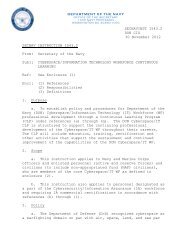HowToFormANonprofit_1st_ed-Chapter3
HowToFormANonprofit_1st_ed-Chapter3
HowToFormANonprofit_1st_ed-Chapter3
You also want an ePaper? Increase the reach of your titles
YUMPU automatically turns print PDFs into web optimized ePapers that Google loves.
Starting A Nonprofit: What You Ne<strong>ed</strong> To Know, 1 st Ed. – Chapter 3<br />
2. Interm<strong>ed</strong>iate Stage of Operation<br />
Once the nonprofit is providing quality services and generating sufficient funds to cover agency<br />
costs, it may expand its activities to include legislative advocacy. The committee that had serv<strong>ed</strong><br />
initially as an information vehicle for Board Members regarding legislative issues might readily<br />
be transform<strong>ed</strong> into a Legislative Advocacy Committee. Since the nonprofit at this point should<br />
be sufficiently advanc<strong>ed</strong> to support a paid Executive Director, that person or a senior staff<br />
designee could work with the Board to design and implement lobbying efforts. The Executive<br />
Director, who in a small organization will have taken on risk management activities in any event,<br />
will serve as the watchdog to be sure that IRS limits on lobbying are not violat<strong>ed</strong>.<br />
3. Advanc<strong>ed</strong> Stage of Operation<br />
After a few years in existence, the Board of Directors may come to look upon its Legislative<br />
Advocacy Committee as a key contributor to the welfare of the community. Following a<br />
legislative victory, perhaps adoption by the General Assembly of a statutory requirement that<br />
health insurance policies issu<strong>ed</strong> in the Commonwealth provide certain benefits for cancer<br />
survivors, the committee may be ready to become even more aggressive on the state or national<br />
level. There are several options available at this point. The nonprofit may elect the §501(h) status<br />
which will enable the organization to fund more lobbying activities than it had up to that point or<br />
it may decide at this juncture to spin off a separate nonprofit specifically devot<strong>ed</strong> to advocacy<br />
with §501(c) (4) exempt status. The major restriction on operating two entities will be that funds<br />
from one organization must not finance activities of the other. A third alternative may be to join<br />
forces with another nonprofit that has a similar focus, like the American Cancer Society, and<br />
jointly operate an advocacy organization. As the nonprofit matures, it will consider the wisdom<br />
of hiring designat<strong>ed</strong> staff to carry on lobbying activities. Hiring such staff means conforming to<br />
additional f<strong>ed</strong>eral and state regulations which the Executive Director should research before any<br />
hiring takes place.<br />
C. Restrictions on Business Activities: Unrelat<strong>ed</strong> Business Income Tax<br />
The IRS will hold the nonprofit to activities that conform to its enumerat<strong>ed</strong> purposes. Charters<br />
and by-laws may, of course, be amend<strong>ed</strong> by the Board of Directors. Are there other permissible<br />
ways for a nonprofit to add activities that are not “substantially relat<strong>ed</strong>” to the charitable purpose<br />
defin<strong>ed</strong> in the original charter of incorporation? Yes, it may undertake these new business<br />
activities that are unrelat<strong>ed</strong> to the original purpose, providing that it pays tax to the f<strong>ed</strong>eral<br />
government, the Unrelat<strong>ed</strong> Business Income Tax. If the nonprofit fails to pay the tax, the IRS<br />
may penalize the organization through monetary penalties or even the loss of its tax exemption.<br />
A nonprofit, therefore, has a choice regarding business unrelat<strong>ed</strong> to its original purpose, much as<br />
it does with regard to lobbying. If a nonprofit wishes to engage in an unrelat<strong>ed</strong> business activity,<br />
it must pay tax on this activity. It may wish to split off such ventures into for-profit subsidiaries<br />
for which it will not claim a tax exemption but pay the corporate income tax. The after tax<br />
income of these subsidiaries continue to support the tax exempt organization. The advantage of<br />
creating the taxable subsidiary is that it will prevent IRS concern regarding the tax exempt status<br />
of the original nonprofit organization.<br />
15





